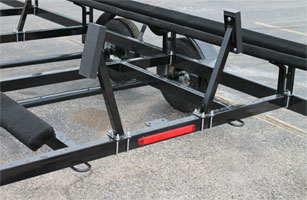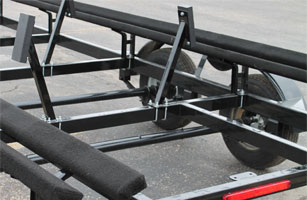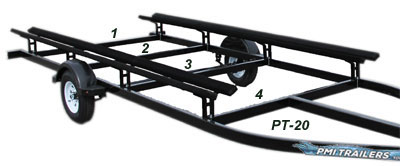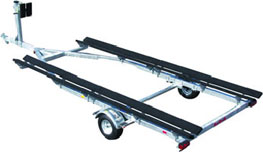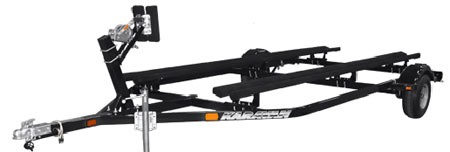| PONTOON TRAILER LOAD and WIND GUIDES | |||||||||||||
| We are frequently asked to make a recommendation on the need for trailer load or wind guides. If the trailer market wasn’t so competitive we’d make them standard. But on quiet inland lakes they often aren’t needed. Yet if you retrieve your pontoon on a windy day or if you boat on a lake with wave action, you will ultimately want them. | |||||||||||||
| About Load Guides for Pontoons | |||||||||||||
|
We’ve sold pontoon trailer guide on’s for 20 years and handled whatever type our
trailer manufacturers offered. One company supplied angled load guides, another
has straight ones, and another manufacturer that didn’t have many cross members
on the trailer had 10’ long load guides. One boasted that his were super strong.
As prices increased we started thinking about making our own. We investigated
which kind of load guide was the best and discovered that no one had really ever
looked into this before. Here’s what we found. Angled are better than straight. - Many pontoons have spray shields welded on the nose cone of the pontoon. Angled load guides help prevent damaging the pontoon spray shields. The height is important. - If too tall even angled guides can interfere with the spray fins. But they need to be tall enough to hit the lower portion of pontoon tube but no taller. To much strength is not a benefit. - Load guides should be sacrificial. If you come in too hard you want the load guide to give, not the expensive pontoon tube. Most load guides bunks are wood covered by carpet. - The carpet frequently gets scuffed and can quickly deteriorate. We decided to make ours plastic. Individual load guides are preferable to bunks. - You can move individual load guides up and down on the trailer frame. If you launch in shallow water you want them in the stern. If you launch on a deep ramp, you want them forward. |
|||||||||||||
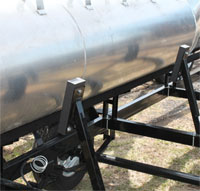 |
 Our load guides are low enough to clear most spray shields. Even the shield to the left that angles down isn’t a problem. Other taller load guides will catch these two spray shields every time. |
||||||||||||
|
|||||||||||||
| Pontoon Trailer Load
Guides Sold in a set of four. Angled brackets will be installed on two tube trailers, straight on tri tube trailers. |
|||||||||||||
 Mounting the Pontoon Load Guide to the Trailer Frame Our pontoon load guides are made to fit our standard 2” x 3” or 4” trailer frame. They mount with a 2 1/2” x 4 1/2” U bolt. Larger trailers sometimes have a 2” x 5” frame and mount with a 2 1/2” x 5 1/2” U bolt. If you’re ordering our load guides for a trailer other than ours, double check the size of your frame. We supply either size U bolts, but different brands of trailers may have different size frames. |
|||||||||||||
| Installing Pontoon Trailer Guides | |||||||||||||
| Before installing your Load Guides from Trailers for Pontoons, a
moment considering where you launch will help you make a better installation. Our trailers have four to six cross members. |
|||||||||||||
|
|||||||||||||
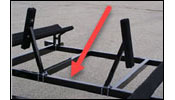 If
you launch on a relatively shallow ramp, mount one pair of load guides on
the back cross member (1). If you often launch on a deep ramp, mount the
back guides on the second (2) cross member from the back as seen to the
left. On deep ramps, guides mounted on the back may be beneath the
water and do you no good. The second set should usually be on the third (3)
or on larger trailers (with more cross members) the front (4). Generally
speaking load guides mounted too far forward don’t do anything because the
pontoon is already onto the trailer. If
you launch on a relatively shallow ramp, mount one pair of load guides on
the back cross member (1). If you often launch on a deep ramp, mount the
back guides on the second (2) cross member from the back as seen to the
left. On deep ramps, guides mounted on the back may be beneath the
water and do you no good. The second set should usually be on the third (3)
or on larger trailers (with more cross members) the front (4). Generally
speaking load guides mounted too far forward don’t do anything because the
pontoon is already onto the trailer. |
|||||||||||||
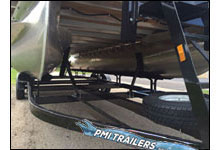 Trailer load guides should be mounted 2” to 4” inches away from the pontoon tube. The boat in the image to the left was set up by a marine dealer but it’s wrong. The load guides are tight against the tubes. It’s the trailer owner’s responsibility to make sure that your trailer is set up properly. |
|||||||||||||
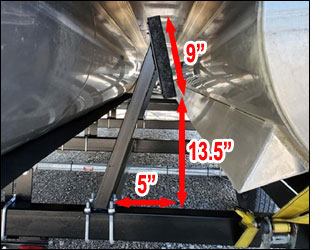 When you buy a trailer from Trailers for Pontoons we install the load guides but we tell you that they may need to be adjusted. We make a guess at where they should be but with 19”, 21” ,23” and 25” diameter tubes, it’s best to adjust the load guides with the boat on the trailer. |
|||||||||||||
| Trailer Load Guides on Other Brands of Trailers | |||||||||||||
| We sell trailer load guides as after market items, but sometimes customers are disappointed when they get ready to install them. The two brands of trailers shown below only have a back cross member. The only place you can mount load guides on trailers made this way is on the back cross member and on a deep ramp they do no good. | |||||||||||||
|
|||||||||||||

